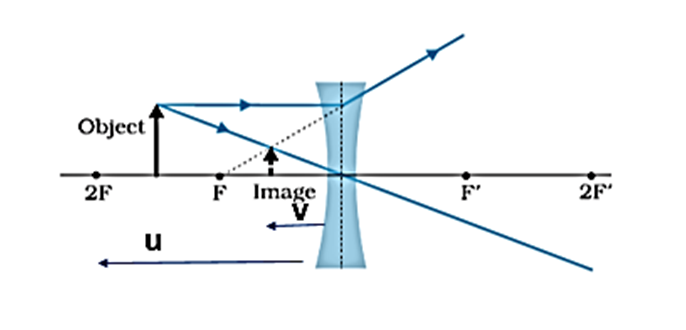
An object placed $50cm$ from a lens produces a virtual image at a distance of $10cm$ in front of the lens. Draw a diagram in order to show the formation of the image and calculate the focal length of the lens.
Answer
516.6k+ views
Hint: The distance from the lens to the focal point is known as the focal length. For a converging lens also known as convex lens, the focal length is always positive, while for a diverging lens or concave lens it always has negative focal lengths.
Complete answer:
The focal length of a lens is dependent on the radii of curvature of its surfaces and on the index of refraction of the material the lens is produced from. As the focal length is the characteristics of a lens and colour of light is dependent on wavelength. Therefore the focal length of the lens is independent of the colour, wavelength and the frequency of the light which is entering through the lens.
Now as per the question, the distance of object from the lens is,
$u=-50cm$
And also the distance of the image from the lens is given as,
$v=-10cm$
As we all know the focal length of a lens is given by the equation,
$\dfrac{1}{f}=\dfrac{1}{v}-\dfrac{1}{u}$
Substituting the values in the given equation will give,
$\dfrac{1}{f}=\dfrac{1}{-10}-\dfrac{1}{-50}$
Simplifying,
$f=-12.5cm$
As the focal length is obtained as negative, the lens is found to be a concave lens. So the ray diagram will look like this,

Note:
The focal length of a lens is dependent on the medium surrounded. The reason for this phenomenon is that the angle of refraction of a lens is dependable on the indices of refraction of the medium of the lens and the incoming medium and the difference in their refractive indices.
Complete answer:
The focal length of a lens is dependent on the radii of curvature of its surfaces and on the index of refraction of the material the lens is produced from. As the focal length is the characteristics of a lens and colour of light is dependent on wavelength. Therefore the focal length of the lens is independent of the colour, wavelength and the frequency of the light which is entering through the lens.
Now as per the question, the distance of object from the lens is,
$u=-50cm$
And also the distance of the image from the lens is given as,
$v=-10cm$
As we all know the focal length of a lens is given by the equation,
$\dfrac{1}{f}=\dfrac{1}{v}-\dfrac{1}{u}$
Substituting the values in the given equation will give,
$\dfrac{1}{f}=\dfrac{1}{-10}-\dfrac{1}{-50}$
Simplifying,
$f=-12.5cm$
As the focal length is obtained as negative, the lens is found to be a concave lens. So the ray diagram will look like this,

Note:
The focal length of a lens is dependent on the medium surrounded. The reason for this phenomenon is that the angle of refraction of a lens is dependable on the indices of refraction of the medium of the lens and the incoming medium and the difference in their refractive indices.
Recently Updated Pages
A man running at a speed 5 ms is viewed in the side class 12 physics CBSE

The number of solutions in x in 02pi for which sqrt class 12 maths CBSE

State and explain Hardy Weinbergs Principle class 12 biology CBSE

Write any two methods of preparation of phenol Give class 12 chemistry CBSE

Which of the following statements is wrong a Amnion class 12 biology CBSE

Differentiate between action potential and resting class 12 biology CBSE

Trending doubts
What are the major means of transport Explain each class 12 social science CBSE

Which are the Top 10 Largest Countries of the World?

Draw a labelled sketch of the human eye class 12 physics CBSE

How much time does it take to bleed after eating p class 12 biology CBSE

Explain sex determination in humans with line diag class 12 biology CBSE

Explain sex determination in humans with the help of class 12 biology CBSE




